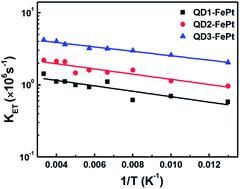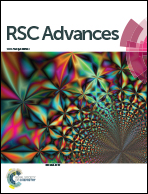Photoluminescence quenching and electron transfer in CuInS2/ZnS core/shell quantum dot and FePt nanoparticle blend films†
Abstract
The photoluminescence (PL) quenching of CuInS2/ZnS quantum dots (QDs) in blend films with FePt magnetic nanoparticles (MNs) was studied by steady-state and time-resolved PL spectroscopy. ZnS shell-coated CuInS2 QDs having various Cu/In molar ratios were synthesized via a hot-injection method. The PL peak of the QDs with enlarged band gap varied from 680 to 610 nm by decreasing the Cu/In ratio. The highest PL quantum yield of 44% was obtained for CuInS2/ZnS QDs with an optimum Cu/In ratio of 1/6. A decrease in PL intensity and lifetime was observed in the blend films of CuInS2/ZnS QDs and FePt MNs with different concentrations, demonstrating that electron transfer occurred from CuInS2 QDs to FePt MNs. Moreover, the rate and efficiency of electron transfer as a function of the concentration ratio of FePt MNs to CuInS2 QDs and temperature were obtained. It was found that the electron transfer rate significantly increased with increasing the FePt MN concentration and the temperature. Therefore, the experimental results indicated electron transfer-induced PL quenching in CuInS2 QD and FePt MN blend films should be considered in designing magnetic–fluorescent nanocomposite structures for realizing highly efficient PL.


 Please wait while we load your content...
Please wait while we load your content...